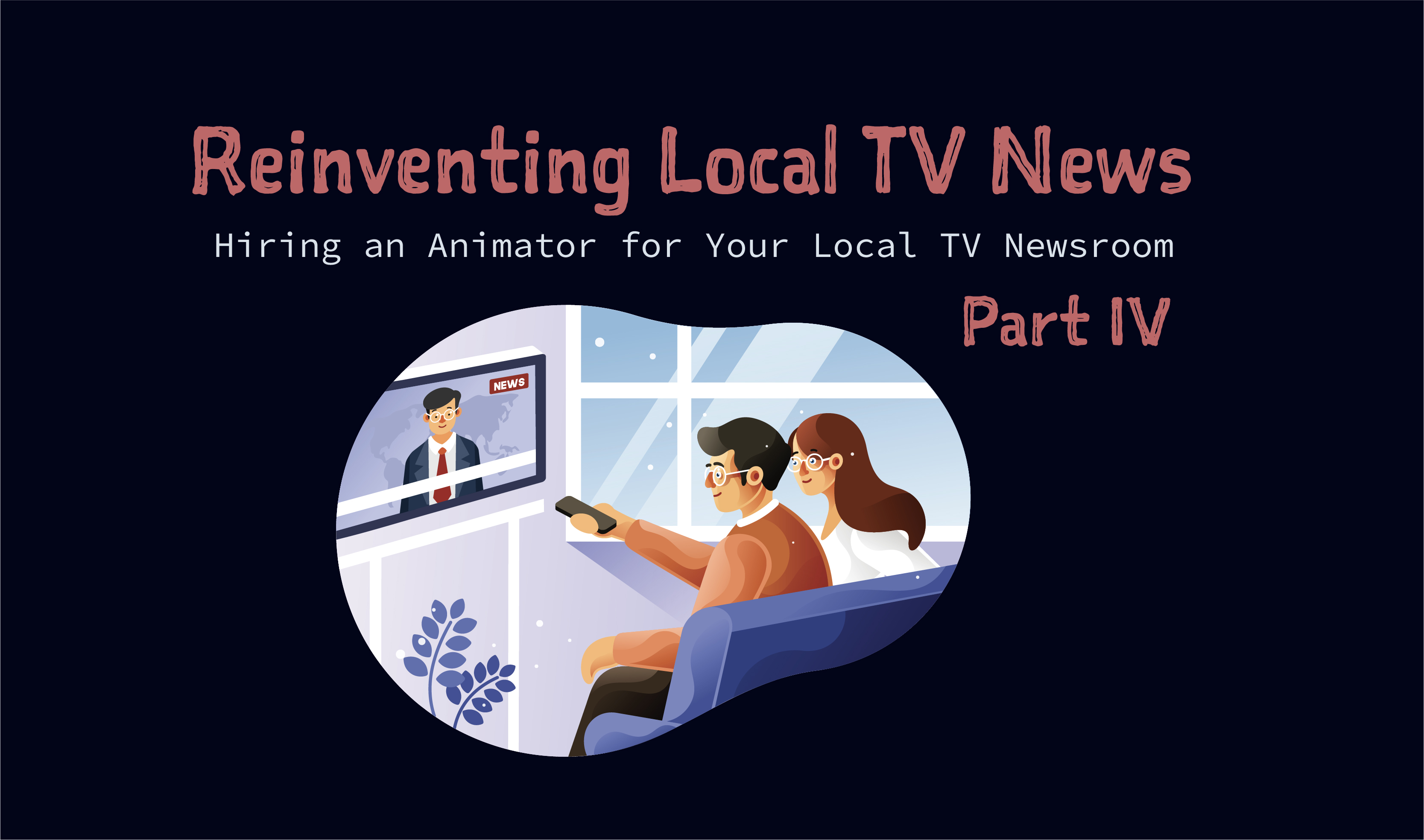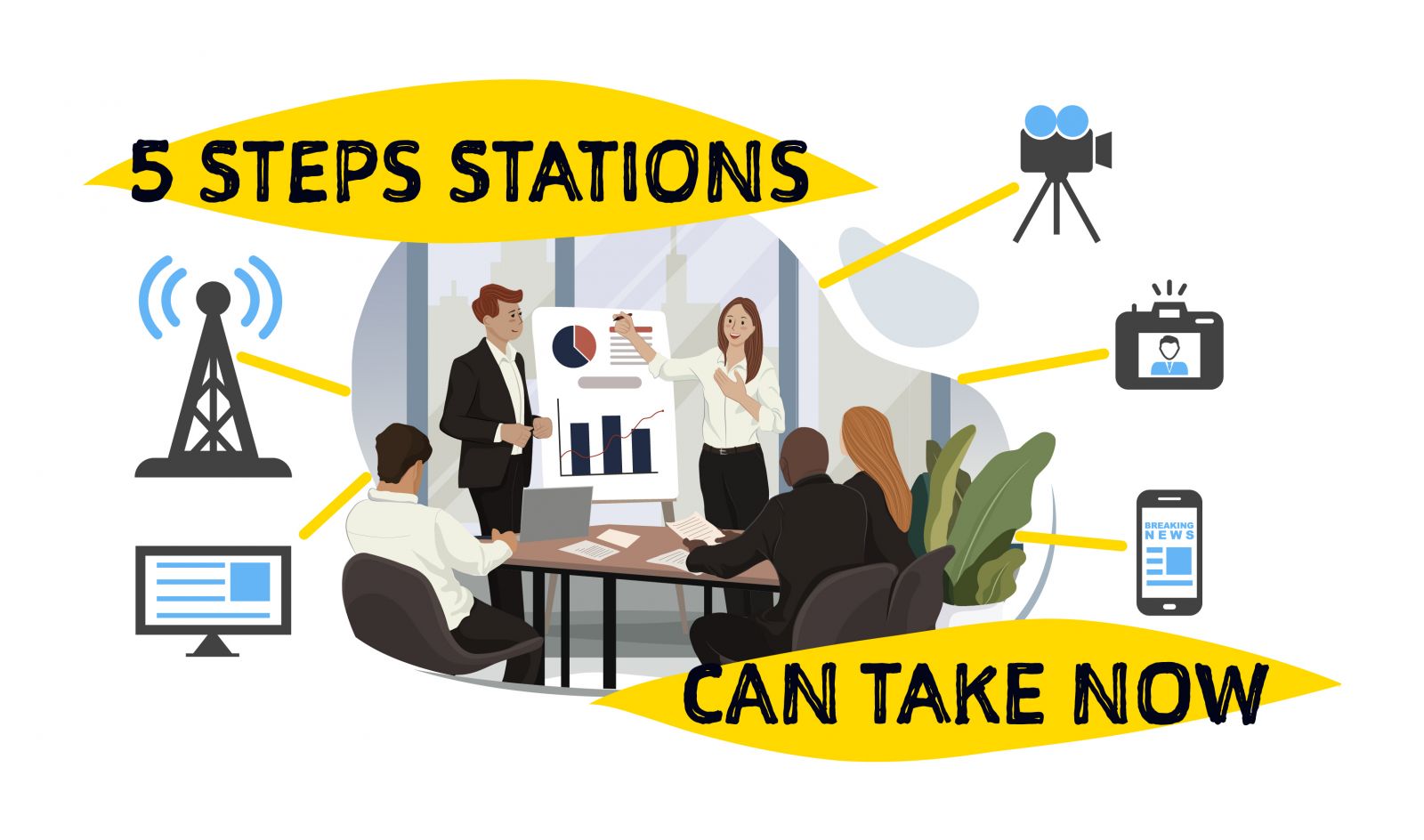Hiring an Animator for Your Local TV Newsroom

By Mike Beaudet, Anna Campbell, and John Wihbey
Benefits, Costs and the Future of Storytelling
Two years of research has convinced us to double down on a recommendation we first made to local television stations in 2019: improve the quality, design, and explanatory power of your storytelling by embedding an animator centrally in the editorial workflow. We now have the results of a real-world experiment in two newsrooms and the audience research data to back it up. It’s clear that the potential benefits of hiring an animator outweigh the costs. In this final post with RTDNA, we’re outlining the investment that could be made and providing an action plan for television stations eager to prioritize animation and graphics in their video news storytelling.
First, a shout out to a few local TV news storytellers who are already producing incredible work with animation. We know there are even more out there—and we salute all of you and urge you to send us your work—for example, check out Chris Chmura’s reporting in San Francisco and Chris Vanderveen’s award-winning investigation in Denver.
Next, a quick reality check about the state of the local television industry and a reminder about why the Reinventing Local TV News (RLTVN) Project at Northeastern University is focused on the future of this medium.
Local TV news is navigating an arduous path in 2021 and beyond. On the one hand, it’s a trusted source that people turn to for news and information. Its business model is also largely working—at the moment. On the other hand, the audience is continuing to shift away from traditional broadcast television consumed in the living room and expecting content delivered immediately on digital devices right in the palm of their hands. These challenging times for the industry demand innovation and creativity. We believe compelling video storytelling enhanced by the use of animation and graphics is an important way to meet the evolving news audience where they are now and where they’re going in the months and years ahead.
How We Got Here
In our research series here at RTDNA, we’ve been exploring what the newsroom of the future could look like. In Part I, we gave an overview of our project and topline findings, including why enhanced animation and graphics appeal broadly to local television news audiences, as well as the implications of these strategies for building station viewership and loyalty.
Fruitful partnerships with WLS-TV ABC7 Chicago and WCVB-TV NewsCenter 5 Boston allowed our experiments with visual innovation to thrive in their newsrooms. We embedded animators known as Visual Content Producers (VCPs) for one-year fellowships with the support of the Stanton Foundation. Read more about their experiences, the value they brought to the newsroom, and their recommendations for future iterations of this role in Part II.
Increasingly, journalists must hone the ability to (1) distill down the exponential complexity of our world, and (2) respond to the active role audiences now play in their choice of information sources. Check out Part III for a deep-dive on our research data and to download our entire slide deck for your own use. Our main takeaway: animated approaches are not only preferred, but can help audiences absorb quantitative or abstract information in a more concrete way. Stations can trust that shuffling more resources toward animation and graphics will satisfy and impress their loyal core viewer base, as well as attract an influx of viewers from young and diverse demographics.
 Five Steps Stations Can Take Now
Five Steps Stations Can Take Now
Prioritize Graphics & Animation in Your Storytelling
Don’t think of animation and graphics as something you add to a story after it’s been thoroughly reported on. Figure out which stories would benefit from animation. Could the data you obtained be visualized? Does a complex process need to be explained? Does the story simply lack visuals? The research proves audiences connect with graphics and animation so keep that in mind as you produce your stories.
Hire an Animator (Visual Content Producer) & Provide Animation & Graphics Tools & Training to Your News Team
Think about making this investment as part of your overall newsroom strategy for evolving your product both on-air and on digital platforms. The animators in our experiment were called Visual Content Producers for a reason: they’re producers involved in the editorial process. Include the animators early on in the reporting as ideas are being developed and let their expertise help guide the storytelling and production for added effectiveness. Even if an animator isn’t in your budget, help your editors in this role by giving them animation training and tools, including Adobe After Effects.
Create a Next-Gen Storytelling Team That is Focused on New Ways of Delivering Content On-Air & on All Your Digital Platforms
We all know our audience (and all of us) get more and more of our news through digital platforms, but we still focus most of our resources on our on-air products. A next-gen storytelling team isn’t a gimmick. It’s an attempt to pull a group of employees from throughout the newsroom to help translate their ideas about innovation in both of these areas into reality. It also tells your news employees, and more importantly, your audience, that you're committed to new forms of storytelling across the board. Newsroom collaboration with smart and creative people who believe in the power of the medium can lead to fresh approaches on-air and online that will better serve audiences of all ages.
Empower Your Current Graphic Design Pros & Work to Achieve Buy-In on All Levels From Producers & Reporters to Photographers & Editors
Hiring an animator when you already have a graphic designer can “ruffle some feathers.” We saw this in both newsrooms and believe an open dialogue about the role and how it fits in with the overall station objectives is key. In some cases, prioritizing animation and graphics with your current graphic design team may be the best approach. Help them understand that the newsroom is valuing what they do more than ever so they don’t view this change as a threat to their jobs.
Host a Workshop with the Reinventing Local TV News Project
We’re excited to take our research on the road in the coming months. We’d love to visit your station or host a virtual workshop where we’ll help your team map out a plan for prioritizing graphics and animation and give you some tools to get started.
Pro-Forma: Cost Benefit Analysis
For our experiment, we hired two VCPs, placed them in newsrooms in Chicago and Boston, and compensated them $85,000 for their year of work with the generous support of the Stanton Foundation. We also factored in 30% for benefits ($25,500), plus $2,500 for specialized animation software including Autodesk Maya for a total budget of $113,000 for each station. We believe this salary is on the higher-end of the range that could be offered. Other newsrooms might of course need to bring those figures more in line with what they can offer in their market (see industry salary data).
Did the investment pay off? While it’s difficult to tease out the effects of a single strategy on our test stations’ overall annual revenue, a local news team can be confident it is succeeding if it can increase (1) ratings/viewership, and (2) digital engagement.
Both WLS-TV and WCVB-TV saw their ratings increase in 2020 during the time the VCPs worked at the stations. To be fair, this clearly had something to do with the pandemic and people spending more time at home in front of their televisions, and relying on up-to-the-minute coverage more than ever. But both stations also believe the VCPs added meaningful value that made the investment more than worthwhile.
“Nothing's in a vacuum. This alone didn't increase ratings by X. [Ratings rise] if you get all the right pieces together, including how you use your digital platforms and what you did on air,” says Bill Fine, the recently retired President and General Manager of WCVB-TV “To me, if you're already a number one or number two, the question is, do you want to be even more dominant? And if you're number three, trying to crack that number one or number two, is [animation] something I can do?”
As our data clearly suggest, enhancing news programs with animation can skyrocket your station’s potential to bring in new audiences channel-surfing for the best content. It’s too soon to say exactly how animation impacted our test stations’ overall audience makeup, but growing a large, diverse viewer base has dramatic implications for reach, reputation, ratings, and heightened advertiser interest.
Finally, contemporary news sources must invest in building a robust online presence to garner trust and interaction from their viewers. In particular, snappy graphics and data visualization pay double dividends: time and resources spent on researching and designing an infographic, for example, can enhance one or more broadcasts as well as provide high-quality standalone content for digital platforms and OTT apps. Over the course of our study, the stories with additional motion graphics work from WCVB’s VCP, Bob Curran, garnered higher-than-average engagement and completion rates among visitors to WCVB’s website. Today, digital engagement is the main hurdle facing broadcasters and has been correlated with higher ratings.
In some cases, station resources can be leveraged on a national scale. ABC Owned Television Stations ended up hiring WLS-TV’s VCP, Adriana Aguilar, full-time after her fellowship ended so her design work could benefit all eight Owned and Operated (O&O) stations across the country.
“You know, at certain times, WLS in Chicago needs work from Adriana a great deal more than maybe other weeks. But when you combine all eight stations’ needs or desires, you really have a resource that can be used across the whole group,” says John Kelly, Director of Data Journalism for ABC Owned Television Stations. “So, yes, we're committed to continuing investing in this in the long-term across our group.”
What's Next
Our research is a work in progress. We’d love to hear what you’re doing in this area and are happy to answer any questions you might have about this series. You can contact project lead Mike Beaudet at m.beaudet@northeastern.edu. We’re also looking for stations to host us for a free in-person or virtual workshop. We'll dive deep into the data relevant to your workflow and audience, answer specific questions you may have, and even provide some motion graphics templates to get you started on refreshing your storytelling. Sign up here.
Here’s to a bright future for the local TV news industry. Our democracy is counting on it.
Mike Beaudet and John Wihbey are professors at Northeastern University’s School of Journalism. Anna Campbell is a Video Innovation Scholar in the graduate program at Northeastern. Beaudet is also an investigative reporter for WCVB-TV Boston.
